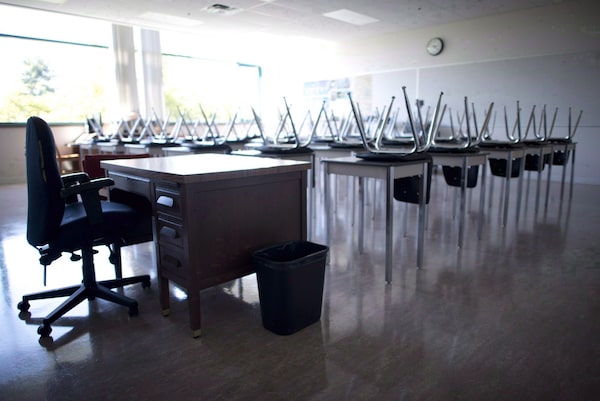
More than 270 schools in Alberta had two to four COVID-19 cases, and another 61 were on high alert, meaning they had five to nine cases.JONATHAN HAYWARD/The Canadian Press
About one in seven schools in Alberta have two or more COVID-19 cases, provincial data show, as parents and school officials grow increasingly concerned that children are not being protected in classrooms.
A month into classes, the province reversed course and said that it would resume publicly reporting COVID-19 cases in schools and conducting contact tracing, although it put the onus on school authorities to notify families of close contacts until its system is set up.
More than 270 schools had two to four cases, and another 61 were on high alert, meaning they had five to nine cases. Eight schools had outbreaks with 10 or more cases within a 14-day period, according to Alberta Health Services data. The government did not indicate the total number of cases in schools with an outbreak. Last week, there were nearly 50 schools with outbreaks.
Alberta resumes COVID-19 contact tracing in schools, orders rapid testing
The question of what role schools play in the spread of COVID-19 has been debated since the beginning of the pandemic. So much depends on the amount of virus circulating in the community and on the infection-control measures, including masks and physical distancing, taken inside school buildings.
Brandi Rai, president of the Alberta School Councils’ Association, said that schools have been an afterthought for the provincial government. Last year, when a positive case was identified in a classroom, students temporarily switched to online learning. Now, students in kindergarten to Grade 6 will move to remote learning only if there are three or more cases over a five-day period, the government said.
Ms. Rai is concerned that the government’s health and safety protocols won’t go far enough to keep students safe, especially those who are not yet eligible for the vaccine.
“We’re asking for there to be more transparency, and why decisions are being made that are different than the protocols we had last year that we saw work,” Ms. Rai said.
She added: “I believe that by Christmas time there will be so many schools with outbreaks and alerts and having to move online that it will once again affect the continuity of learning that children are experiencing, because we do not have pro-active leadership in making those schools sustainably safe.”
Alberta’s Chief Medical Officer of Health, Deena Hinshaw, told reporters at a briefing on Thursday that the government wants to minimize disruptions to learning. She said that officials studied other jurisdictions and found that it is “relatively uncommon” to see the virus spread to multiple people from a single infectious person if other safety measures are in place. She explained that the threshold of three cases within five days was high enough to not disrupt classroom learning, but low enough to pick up cases relatively early before the virus spreads further.
“Having an entire classroom move to online learning when a single infectious person is present is a low threshold that would likely cause more harm than good in terms of disruption that that would cause for those individuals and families,” Dr. Hinshaw said.
The government has also announced it will offer rapid tests for students in kindergarten to Grade 6 if there is an outbreak at their school. Dr. Hinshaw said that the measure is best used in settings where there is a high risk of the virus spreading, and that in schools where the prevalence of COVID-19 is low, there is a risk of more false positives, which would disrupt learning.
Limiting rapid tests to settings where officials know there have been potential exposures means, “they can do the most good by minimizing the chance that there is any further transmission,” she said.
Trisha Estabrooks, chair of Edmonton Public Schools, disagrees. She said that as the province fights the fourth wave, rapid tests should be distributed to a classroom when there’s a case present, not just to schools with an outbreak.
“These are the kinds of supports that parents and families that I represent are begging for. So, let’s give it to them,” she said.
Her board recently passed a motion to request that the Alberta government close all schools for two weeks. There are roughly 850 self-reported cases in her board. “If in-person learning had truly been prioritized in August, we wouldn’t even be in this situation of talking about a circuit breaker,” she said. “Here we are in the middle of a fourth wave, we opened schools and still we don’t have the necessary protocols in place.”
Leyla Asadi, an infectious-diseases physician in Edmonton, is also critical of the government’s efforts to lower transmissions in schools. The mask mandate for students in Grades 4 and higher should be extended to younger grades, she said, and the government should be deploying asymptomatic surveillance rapid testing in schools.
Some school divisions have mandated mask use in younger grades, but “there’s only so much that can be done at the local level without a provincial response,” Dr. Asadi said. “These issues really shouldn’t be offloaded onto local school boards.”
With files from James Keller
Sign up for the Coronavirus Update newsletter to read the day’s essential coronavirus news, features and explainers written by Globe reporters and editors.
 Caroline Alphonso
Caroline Alphonso